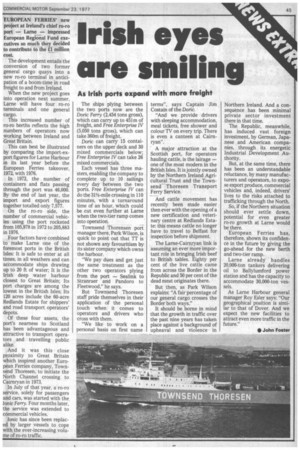Irish eyes are smiling
Page 51

If you've noticed an error in this article please click here to report it so we can fix it.
As Irish ports expand with more freight
EUROPEAN FERRIES' new project at Ireland's chief ro-ro port — Lame — impressed European Regional Fund executives so much they decided to contribute teTtile El million cost.
The development entails the conversion of two former general cargo quays into a new ro-ro terminal in anticipation of a boom-time in road freight to and from Ireland.
When the new project goes into operation next summer, Lame will have four ro-ro terminals and one general cargo.
This increased number of ro-ro berths reflects the high numbers of operators now working between Ireland and Great Britain.
This can best be illustrated by comparing the import-export figures for Lame Harbour in its last year before the European Ferries takeover, 1972, with 1976.
In 1972, the number of containers and flats passing through the port was 46,000. By the end of last year, the import and export figures together totalled only 7,577.
On the ro-ro side, the number of commercial vehicles using the port rocketed from 105,978 in 1972 to 205,883 in 1976.
Four factors have combined to make Larne one of the foremost ports in the British Isles: It is safe to enter at all times, in all weathers and can accommodate ships drawing up to 20 ft of water; It is the Irish deep water harbour closest to Great Britain; Its port charges are among the lowest in the British Isles; Its 120 acres include the 60-acre Redlands Estate for shippers' and road transport operators' depots.
Of these four assets, the port's nearness to Scotland has been advantageous and attractive to transport operators and travelling public alike.
And it was this close proximity to Great Britain which inspired another European Ferries company, Townsend Thoresen, to initiate the North Channel crossing to Cairnryan in 1973.
In July of that year, a ro-ro service, solely for passengers and cars, was started with the, Ionic Ferry. Four months later, the service was extended to commercial vehicles.
Ionic has since been replaced by larger vessels to cope with the ever-increasing volume of ro-ro traffic. The ships plying between the two ports now are the Doric Ferry (2,454 tons gross), which can carry up to 451m of freight, and Free Enterprise IV (5,050 tons gross), which can take 360m of freight. Doric can carry 15 containers on the upper deck and 30 mixed commercials below; Free Enterprise IV can take 26 mixed commercials.
Each vessel has three masters, enabling the company to complete up to 10 sailings every day between the two ports. Free Enterprise IV can do the 311/2-mile crossing in 110 minutes, with a turnaround time of an hour, which could be cut even further at Lame when the two-tier ramp comes into operation.
Townsend Thorensenport manager there, Park Wilson, is quick to point out that TT is not shown any favouritism by its sister company which owns the harbour.
"We pay dues and get just the same treatment as the other two operators plying from the port — Sealink to Stranraer and Pandoro to Fleetwood," he says.
But Townsend Thoresen staff pride themselves in their application of the personal touch when it comes to operators and drivers who cross with them.
"We like to work on a personal basis on first name terms", says Captain Jim Costain of the Doric.
"And we provide drivers with sleeping accommodation, meal tickets, free shower and colour TV on every trip. There is even a canteen at Cairnryan".
A major attraction at the Scottish port, for operators hauling cattle, is the lairage — one of the most modern in the British Isles. It is jointly owned by the Northern Ireland Agricultural Trust and the Townsend Thoresen Transport Ferry Service. And cattle movement has recently been made easier then ever with the opening of a new certification and veterinary centre at Redlands Estate: this means cattle no longer have to travel to Belfast for inspection before shipment.
The Larne-Cairnryan link is assuming an ever more important role in bringing Irish beef to British tables. Eighty per cent of the live cattle came from across the Border in the Republic and 50 per cent of the dead meat originates there.
But then, as Park Wilson explains: "A fair percentage of our general cargo crosses the Border both ways."
It should be borne in mind that the growth in traffic over the past nine years has taken place against a background of upheaval and violence in Northern Ireland. And a consequence has been minimal private sector investment there in that time.
The Republic, meanwhile, has induced vast foreign investment, by German, Japanese and American companies, through its energetic Industrial Development Authority.
But, at the same time, there has been an understandable reluctance, by many manufacturers and operators, to expose export produce, commercial vehicles and, indeed, drivers' lives to the risks attached to trafficking through the North.
So, if the Northern situation should ever settle down, potential for even greater ro-ro growth at Larne would be there.
European Ferries has, therefore, shown its confidence in the future by giving the go-ahead for the new berth and two-tier ramp.
Larne already handles 20,000-ton tankers delivering oil to Ballylumford power station and has the capacity to accommodate 30,000-ton vessels.
As Lame Harbour general manager Roy Esler says: "Our geographical position is similar to that of Dover. And we expect the new facilities to attract even more traffic in the future."
• John Foster
































































































































